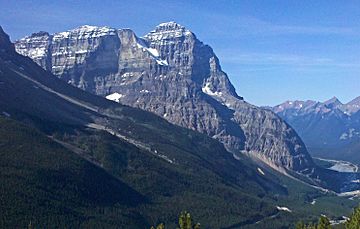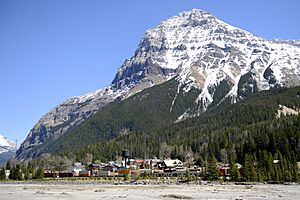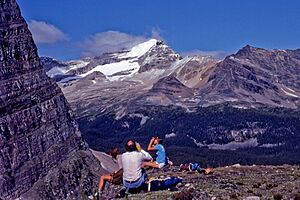Mount Stephen facts for kids
Quick facts for kids Mount Stephen |
|
|---|---|

Mount Stephen towers over the Kicking Horse Valley
|
|
| Highest point | |
| Elevation | 3,199 m (10,495 ft) |
| Prominence | 989 m (3,245 ft) |
| Geography | |
| Parent range | Canadian Rockies |
| Topo map | NTS 82N/08 |
| Geology | |
| Age of rock | Cambrian |
| Type of rock | Sedimentary rock |
| Climbing | |
| First ascent | 1887 by James J. McArthur, T. Riley |
| Easiest route | Scramble (difficult) |
Mount Stephen is a tall mountain in Yoho National Park, Canada. It stands about 3,199 meters (10,495 feet) high. You can find it near the Kicking Horse River Valley, just east of a town called Field in British Columbia.
The mountain was named in 1886 after George Stephen. He was the first president of the Canadian Pacific Railway. Mount Stephen is made of old rocks like shale and dolomite. These rocks formed about 550 million years ago, during a time called the Cambrian Period. A special rock layer, called the Stephen Formation, was first studied here and named after the mountain. Mount Stephen also has a smaller peak nearby called Stephen SE1.
Climbing Mount Stephen
The first people to climb Mount Stephen reached the top on September 9, 1887. They were James J. McArthur and his helper, T. Riley. Their climb was extra hard because they carried heavy surveying tools. Sadly, smoke from forest fires blocked their view from the top.
They started climbing at 4:30 in the morning. It took them four hours to get through a thick forest to reach the treeline. After three more hours, they found rocks with a message carved into them. It said "Hill, Whatley, Ross, September 6, 1886." Above these rocks, they had to cross a tricky ice path and a sharp, narrow ridge.
Later, between 1887 and 1892, a huge amount of rock fell from the mountain. This made the climb much easier for future adventurers.
Main Climbing Route
The most common way to climb Mount Stephen is called a "scramble." This means you use your hands and feet to climb steep slopes. The main route goes up the southwest side of the mountain. It can be hard to find the right path. The last 125 meters (410 feet) to the very top are quite difficult.
Sometimes, a large snow overhang at the top can make it unsafe to reach the summit. If you are not sure about the conditions, it's best to wait until August. This climbing route also goes through an area with many fossils. Because of this, you need a special permit from the park to be there. The total climb gains about 1,920 meters (6,300 feet) in height.
For experienced rock climbers, there is a route on the north ridge. It is rated as a difficult climb (III 5.7). The rocks are usually good for climbing and are mostly made of quartzite.
Mountain Weather
Mount Stephen is in a subarctic climate zone. This means it has cold, snowy winters and mild summers. Temperatures can drop below -20 °C (-4 °F). With wind, it can feel even colder, below -30 °C (-22 °F).
The cold winter weather makes Mount Stephen a great place for ice climbing in the Canadian Rockies. All the rain and melted snow from Mount Stephen flows into the Kicking Horse River.
Gallery








